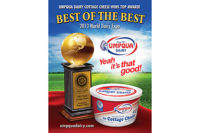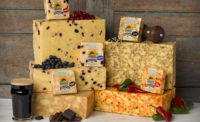For years, cottage cheese sat quietly on the shelf in the dairy case while other dairy products such as yogurt took over entire coolers with numerous brands, dozens of flavors and an assortment of packaging options. While cottage cheese might never be perceived in quite the same way as Greek yogurt, the cultured product does have quite a lot going for it.
Nutritionally, cottage cheese and Greek yogurt have some similarities. A serving (a half cup or around 113 grams) of cottage cheese typically contains around 12-13 grams of protein, which is more than most Greek yogurts. Full-fat cottage cheese contains only around 4-5 grams of fat per serving, and lactose-free options also are available.
Image problem
So why can’t cottage cheese occupy a space similar to yogurt? Cottage cheese does have a bit of an image problem. It has been thought of by some consumers as a “diet” food and is located mostly in salad bars. For a long time, cottage cheese was available only in large, inconvenient containers, and it also didn’t feature any flavorings or mix-in options.
Americans consume about 15 pounds of yogurt per capita compared to about 2 pounds of cottage cheese. However, given cottage cheese’s positive nutritional profile, high protein content, low lactose content and the potential to add in flavorings and even change up its format, we shouldn’t give up on cottage cheese. The washing step in its manufacture also reduces acidity, another positive for many consumers.
Category innovation
For several years now, we’ve seen producers deliver cottage cheese in eye-catching individual-sized containers with an assortment of flavorings and mix-in options. These companies are specifically promoting cottage cheese’s nutritional benefits and also are producing trendy flavoring options such as strawberry chia or honey vanilla. More recently, we’ve started to see more savory flavor options, including creamy jalapeno with tortilla strips.
Other companies are innovating by producing a “clean-label” organic cottage cheese that is free of antimycotics (mold inhibitors). Instead of adding antimycotics to the cream dressing, these companies are using bioprotective cheese cultures that naturally inhibit molds and pathogens. Additionally, these products typically don’t contain any gums or thickeners and have less sugar than many yogurts. Greater attention to quality definitely helps the overall taste of this mild product.
Another innovative product is “smooth” cottage cheese. This product blends the curd and dressing into a smooth (not lumpy) texture and, again, comes in a wide variety of flavors and mix-in options such as s’mores.
We’re also seeing producers selling cottage cheese without the dressing. Traditionally, cottage cheese is produced by making the cheese curd and then adding in a dressing, which is typically some type of cream/cultured milk. However, some are skipping the dressing and producing a type of dry-curd cottage cheese or similar products called farmer cheese.
Looking ahead, we should see more producers coming onto the market with more interesting flavors, textures and packaging options.
Additionally, we might see more innovation in the format beyond smooth, dry curd or double cream. The options with cottage cheese are endless. It’s too bad that for many years, cottage cheese was mostly ignored and thought of as only a diet food; it really deserves more attention. It will be exciting to see where cottage cheese goes in the future.




